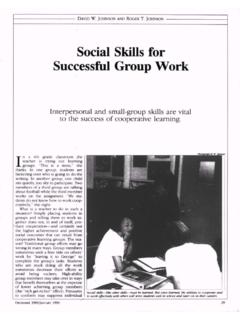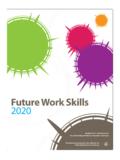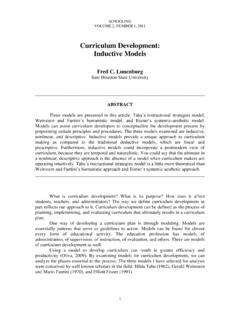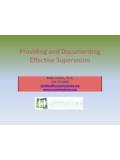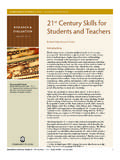Transcription of HIGHER ORDER THINKING SKILLS - cala.fsu.edu
1 HIGHER ORDER THINKING SKILLS Definition Teaching Strategies Assessment FJ King, Ludwika Goodson, Faranak Rohani, A publication of the Educational Services Program, now known as the Center for Advancement of Learning and Assessment HIGHER ORDER THINKING SKILLS Page 1 Executive Summary Definition HIGHER ORDER THINKING SKILLS include critical, logical, reflective, metacognitive, and creative THINKING . They are activated when individuals encounter unfamiliar problems, uncertainties, questions, or dilemmas. Successful applications of the SKILLS result in explanations, decisions, performances, and products that are valid within the context of available knowledge and experience and that promote continued growth in these and other intellectual SKILLS .
2 HIGHER ORDER THINKING SKILLS are grounded in lower ORDER SKILLS such as discriminations, simple application and analysis, and cognitive strategies and are linked to prior knowledge of subject matter content. Appropriate teaching strategies and learning environments facilitate their growth as do student persistence, self-monitoring, and open-minded, flexible attitudes. This definition is consistent with current theories related to how HIGHER ORDER THINKING SKILLS are learned and developed. Although different theoreticians and researchers use different frameworks to describe HIGHER ORDER SKILLS and how they are acquired, all frameworks are in general agreement concerning the conditions under which they prosper. Teaching Strategies Lessons involving HIGHER ORDER THINKING SKILLS require particular clarity of communication to reduce ambiguity and confusion and improve student attitudes about THINKING tasks.
3 Lesson plans should include modeling of THINKING SKILLS , examples of applied THINKING , and adaptations for diverse student needs. Scaffolding (giving students support at the beginning of a lesson and gradually requiring students to operate independently) helps students develop HIGHER ORDER learning SKILLS . However, too much or too little support can hinder development. HIGHER ORDER THINKING SKILLS Page 2 Useful learning strategies include rehearsal, elaboration, organization, and metacognition. Lessons should be specifically designed to teach specific learning strategies. Direct instruction (teacher-centered presentations of information) should be used sparingly.
4 Presentations should be short (up to five minutes) and coupled with guided practice to teach subskills and knowledge. Teacher- and/or student-generated questions about dilemmas, novel problems, and novel approaches should elicit answers that have not been learned already. Sincere feedback providing immediate, specific, and corrective information should inform learners of their progress. Small group activities such as student discussions, peer tutoring, and cooperative learning can be effective in the development of THINKING SKILLS . Activities should involve challenging tasks, teacher encouragement to stay on task, and ongoing feedback about group progress. Computer-mediated communication and instruction can provide access to remote data sources and allow collaboration with students in other locations.
5 It can be effective in skill building in areas such as verbal analogies, logical THINKING , and inductive/deductive reasoning. Assessment Valid assessment of HIGHER ORDER THINKING SKILLS requires that students be unfamiliar with the questions or tasks they are asked to answer or perform and that they have sufficient prior knowledge to enable them to use their HIGHER ORDER THINKING SKILLS in answering questions or performing tasks. Psychological research suggests that SKILLS taught in one domain can generalize to others. Over long periods of time, individuals develop HIGHER ORDER SKILLS (intellectual abilities) that apply to the solutions of a broad spectrum of complex problems. HIGHER ORDER THINKING SKILLS Page 3 Three item/task formats are useful in measuring HIGHER ORDER SKILLS : (a) selection, which includes multiple-choice, matching, and rank- ORDER items; (b) generation, which includes short- answer, essay, and performance items or tasks; and (c) explanation, which involves giving reasons for the selection or generation responses.
6 Classroom teachers recognize the importance of having students develop HIGHER ORDER SKILLS yet often do not assess their students progress. Several performance-based models are available to assist them in teaching and assessing these SKILLS . Comprehensive statewide assessment of HIGHER ORDER SKILLS is feasible but would be expensive. Florida and a number of other states now incorporate the measurement of HIGHER ORDER SKILLS in their statewide assessments. HIGHER ORDER THINKING SKILLS Page 4 TABLE OF CONTENTS Executive Summary ..1 Definition .. 1 Teaching Strategies .. 1 Assessment .. 2 HIGHER ORDER THINKING SKILLS ..7 Definition ..11 Major Concepts.
7 11 Context .. 11 Metacognition .. 11 Procedural Knowledge .. 12 Comprehension .. 12 Creativity .. 13 Insight .. 15 Intelligence .. 16 Problem Solving .. 16 Critical 17 Theories Related to Learning and HIGHER ORDER THINKING SKILLS .. 18 Piaget .. 19 Bruner .. 20 Bloom .. 20 Gagn .. 21 Marzano .. 21 Glaser .. 25 Vygotsky .. 27 Haladyna .. 27 HIGHER ORDER THINKING SKILLS Page 5 Gardner .. 28 Summary of the Development of HIGHER ORDER THINKING SKILLS .. 32 Level 1: Prerequisites .. 38 Level 2: Bridges .. 39 Level 3: HIGHER ORDER THINKING .. 40 Teaching Strategies ..41 Specific Methods and Strategies to Enhance HIGHER ORDER THINKING SKILLS .. 44 Instructional Communications.
8 44 Scaffolding .. 46 Learning and THINKING Strategies .. 48 Direct Instruction .. 54 Questioning Strategies .. 56 Feedback .. 57 Team 58 Computer Mediation .. 62 Summary of Teaching Strategies .. 63 Classroom and Statewide Assessment of HIGHER ORDER THINKING SKILLS ..64 Validity and Generalizability of HIGHER ORDER THINKING SKILLS and Dispositions .. 64 Published Measures of HIGHER ORDER THINKING SKILLS .. 71 Item/Test Formats .. 76 Multiple-Choice Items .. 76 Performance Tests .. 78 Portfolios .. 80 Classroom Assessment of HIGHER ORDER THINKING SKILLS .. 81 Assessment Models .. 82 Baker, Aschbacher, Niemi, and Sato .. 82 HIGHER ORDER THINKING SKILLS Page 6 Sugrue.
9 84 The Mid-Continent Regional Educational Laboratory .. 88 The Advanced International Certificate of Education .. 90 The International Baccalaureate Diploma Program .. 92 Statewide Assessment Models of HIGHER ORDER THINKING SKILLS .. 93 Sternberg .. 93 Paul and Nosich .. 93 The Florida Department of Education .. 96 Pennsylvania Department of Education .. 97 Summary of Classroom and Statewide Assessments .. 99 References ..103 Appendixes ..118 Appendix A: Sample Teaching Assignments .. 118 Appendix B: Sample Tests and Test Items .. 145 Appendix C: Other Resources .. 164 Tables ..22 Table 1: Dimensions of THINKING .. 22 Table 2: Activities and Abilities Related to Intelligences .. 29 Table 3: Perspectives About Intelligence .. 31 Table 4: A Sampling of Terms Associated with HIGHER ORDER THINKING .
10 34 Table 5: Development of HIGHER ORDER THINKING SKILLS .. 37 Table 6: APA Summary of Basic Principles of Learning .. 42 HIGHER ORDER THINKING SKILLS Page 7 HIGHER ORDER THINKING SKILLS The challenge of defining THINKING SKILLS , reasoning, critical thought, and problem solving has been referred to as a conceptual swamp in a study by Cuban (as cited in Lewis & Smith, 1993, p. 1), and as a century old problem for which there is no well-established taxonomy or typology (Haladyna, 1997, p. 32). In addition, explanations of how learning occurs have been viewed as inadequate, with no single theory adequately explaining how all learning takes place (Crowl, Kaminsky, & Podell, 1997, p.)
